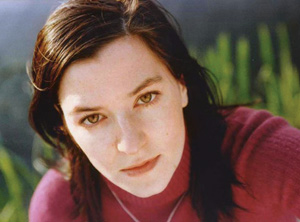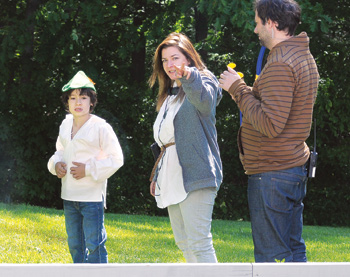BY ANDREW PULVER
 VISUAL THINKER: Ramsay is clear-eyed about her experiences in the
VISUAL THINKER: Ramsay is clear-eyed about her experiences in the
film business and the difficulties of trying to get serious movies made.It's an all-too-common story: a young, uncompromising director arrives with a brilliant debut and follow-up, but when he or she takes tentative steps outside the indie film world, the raw market capitalism of the wider film industry eats them up. Such was the fate that befell British director Lynne Ramsay, who impressed audiences and critics with her first two features—1999's Ratcatcher and 2002's Morvern Callar—but has been struggling ever since to get another project up and running.
Finally, after eight years, Ramsay is midway through postproduction on her third feature, an adaptation of Lionel Shriver's controversial novel We Need to Talk About Kevin. "It's early, but there seems to be a good response," says Ramsay, sitting in her local pub in London. "The script was so precise, so worked out, and we shot exactly that, and it works." The film examines the emotional life of a teenage perpetrator of a high school massacre, as viewed through the eyes of his highly ambivalent mother, played by Tilda Swinton. Tricky, risky stuff, but Ramsay is no stranger to intimidating material. "I'm attracted to challenging subject matter," she says. "I hate being safe. There's a lot of easy rides and boring films out there, but I've stuck to my guns. It's not an easy path."
Ramsay has indeed done well with seemingly unpromising subject matter. Her first film, Ratcatcher, chronicled the travails of a guilt-haunted Scottish child during Britain's notorious garbage collectors' strike in the late '70s; while Morvern Callar, adapted from a novel by Alan Warner, is a sort of Scots answer to Camus' The Stranger, about a near-silent shopgirl who claims authorship of a book written by her dead boyfriend and walks off with the publishing money. Ramsay stamped both films with a highly personal visual style, which was crucial to their effect. She allied a gift for lyrical, poetic image-making with fractured, elliptical storytelling. "I hate exposition and superfluous dialogue," she says. "I hate when dialogue is trying to explain or patronize or finger-point. Cinema is a great medium for creating a dream world and entering into it. Some filmmakers think you need to be told what to think, but I suspect a lot of people like working it out for themselves."
We Need to Talk About Kevin falls in the same bracket of "difficult," non-obvious storytelling. Although Shriver is an American writer, the novel only took off after winning the UK's Orange Prize for Fiction in 2005. "Kevin had no audience when I read it, but I thought it was just a great book. I was the one brave enough to say, 'I'll do it.' But being brave can sometimes be to your detriment."
 BAD BOY: Ramsay with Ezra Miller (left) on the Connecticut set
BAD BOY: Ramsay with Ezra Miller (left) on the Connecticut set
of We Need to Talk About Kevin. Shooting in the U.S. for the
first time was an entirely different experience for her.This Ramsay had certainly found out several years earlier. While shooting Morvern Callar, she was sent the first three chapters of Alice Sebold's The Lovely Bones before its publication that she immediately signed on to direct. Ramsay spent four years fruitlessly developing a screenplay as the novel turned into a surprise bestseller, and the project migrated to DreamWorks where it was directed by Peter Jackson. "It felt more and more that what was wanted was a literal translation of the book," says Ramsay, "and personally, I didn't think that would work. I was putting in more and more drafts and
not getting much reaction."
Ramsay realized that if she directed Bones it would be an important career step for her. "I was in an odd situation, and it became a moral question for me. It could be a climb up the ladder, but at the end of the day I want to make really good films. If I'd put myself in a position where I compromised myself, it would have been a killer for me. As a filmmaker, in my own mind, I need to believe in something."
That's not to say making Kevin has been easy. "I've really battled to make this film, even to the point where we started prep and didn't know if we had the money," says Ramsay. As she tells it, the project fell victim to the financial crisis: initially budgeted at $12 million, she suddenly found herself working with only $8 million after the original backers pulled out. "We had to overhaul the script completely. For $12 million it would have been a different film. I had to be super-economical; the film had to be really bare-bones to get it made. We had a 30-day shoot and an 86-page script. It was scary; we had to be really focused. It was about knowing what you want. There's such a different financial climate after the credit crunch that I feel quite lucky it got up and running."
Shooting in the U.S. (in Stamford, Ct.) for the first time only added to the pressure. "It's a whole different world for me," Ramsay says. "You're essentially moving through an alien landscape, having to cope with different rules of working. It may sound trivial, but I found it hard to get my head around the split between departments. For example, I'm used to going through one designer, but in the States, props and the art department are separate. But the crew was so organized; it was the best I've ever worked with. We had to be, with such a tight schedule. We did three takes max, twenty-five setups a day. It was crazy. They were really behind the project, and I had absolutely top-notch people working on it for very little money."
Ramsay's transformation into a bare-bones, shoot-and-run American-style indie director is even more remarkable considering that her early, formative years as a filmmaker were almost entirely conducted within the shelter of Britain's state-funded system (one that is now seriously threatened by the recent closure of the UK Film Council). A still photographer by training, Ramsay says she had never even picked up a film camera until she landed a spot at the cinematography course in the UK's highly competitive National Film and TV School, more by accident than design. She then transferred to the directing program where "I felt like I was starting from scratch." Her graduation short, Small Deaths, won a prize at the 1996 Cannes film festival. After directing another pair of award-winning shorts, she was invited by the BBC to send them a treatment for a feature, which became Ratcatcher.
In many ways, Ramsay's early career is a textbook case of how state patronage is supposed to work—encouraging and enabling unconventional talent that might otherwise be burned up by the marketplace. "Most of the stuff the film students were shooting were slick calling-card films with a twist in the tale," says Ramsay. "I was very bored with all that. Most people came from a theater background, but I came from a visual background, which was unusual. I mean, I knew how to light and frame, but film is such a different language than still photography. I was a wild card."
Searching for her cinematic voice, Ramsay says she was fortunate to have had the room to experiment and shoot lots of film in different styles, with different stocks. "I knew right away I wanted to tell certain kinds of stories, and it was a real challenge when I first tried to make them. My shorts were naïve, but I had a strong instinct to make a story work through images, create atmosphere, and to make really real performances; it just started to appear."
This is about as articulate as Ramsay gets about her idiosyncratic visual style, something that the casual observer might assume is a highly mannered, honed-to-perfection form of cinematic poetry. But Ramsay says it's all instinct. "I think in images and in a narrative of images. It doesn't make life easy when you're trying to evoke emotions with as little dialogue as necessary." She offers as an example the celebrated dream sequence in Ratcatcher, in which her young lead runs ecstatically through a cornfield. "It was an image I was always very sure about, and it was all scripted. We built a set in a field, but it rained and we only had an hour to get it."
For such a visual filmmaker, it may be a surprise to discover that Ramsay doesn't use storyboards. "They're a waste of time, to be honest. You can do lots of pretty drawings, and then you arrive on set and it's all different. Ratcatcher was a difficult shoot as it rained all that summer, and it was really tough to get exact images. I find shot lists are much more useful. With Kevin I shot-listed the whole film very precisely. But I like having the flexibility to turn up and be able to respond to what's going on, rather than just being mad to get a preconceived idea."
Even with Kevin in the can, Ramsay appears warier than ever about the chances for her kind of filmmaking. "It's always a struggle to make something with an individual voice. The current climate means you have to be smarter as a filmmaker. If Kevin came along now I think I'd have thought it might be too hard to get it made. You need to be resilient and realistic."